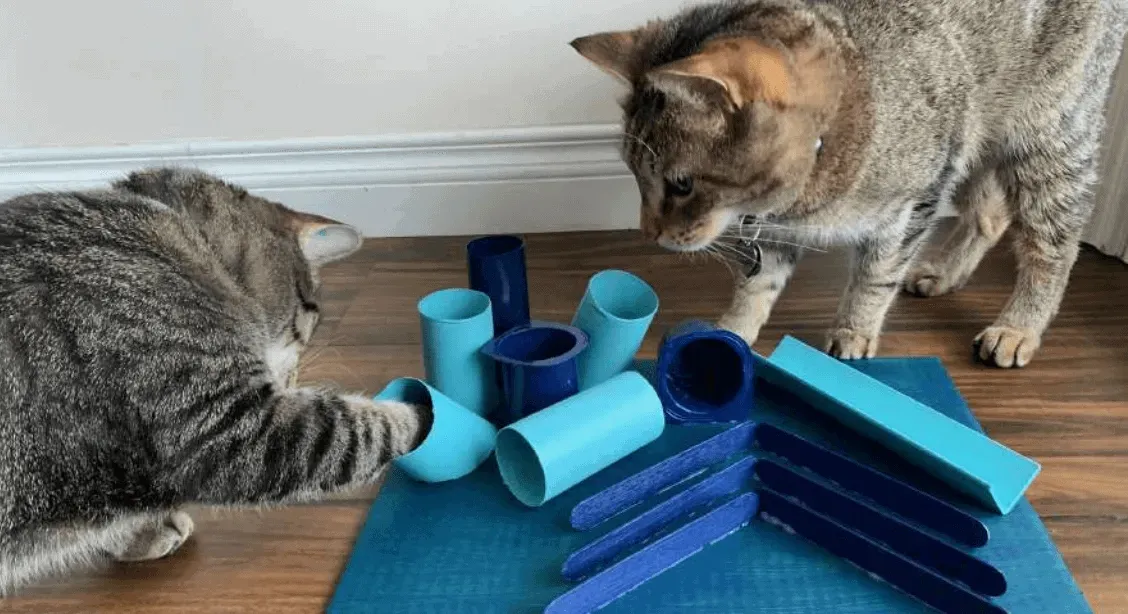Table of Contents
Your cat is giving you *that* look. The one that says, "I'm bored, amuse me," usually right after they've decimated the expensive feathery thing you just bought. Sound familiar? We love our feline overlords, but keeping them entertained and, more importantly, safe, can feel like a constant battle. Store-bought toys can be pricey, and sometimes you look at them and wonder, "Is that plastic eye going to end up in their tummy?"
Why Making DIY Cat Toys Safe Matters Most

Why Making DIY Cat Toys Safe Matters Most
Beyond Just Playtime: The Hidden Dangers
Look, we get it. You see a scrap of fabric, a cardboard tube, and suddenly you're a master toy designer, ready to unleash creative genius on your unsuspecting cat. It feels thrifty, personal, and hey, it's just a toy, right? Wrong. The internet is full of cute ideas, but not all of them pass the safety test. Making diy cat toys safe isn't just a suggestion; it's non-negotiable if you want to avoid an emergency vet visit. A loose string can turn into a digestive nightmare. A small button or plastic eye can become a choking hazard faster than you can say "mouser."
Think about how your cat plays. They pounce, they bite, they shred, they often try to eat things they shouldn't. Their natural instincts, while adorable, mean anything they interact with intensely needs to withstand serious abuse and not break down into ingestible pieces. Ignoring safety when crafting `diy cat toys safe` is like leaving tiny, appealing landmines scattered around your living room. It’s simply not worth the risk to their health and your wallet.
Common Hazards Lurking in Homemade Toys
Let's talk specifics. What exactly are we trying to avoid when focusing on making `diy cat toys safe`? The big ones are ingestion, strangulation, and injury. Anything small enough to swallow is a major red flag. This includes beads, googly eyes, small bells, or even pieces of certain fabrics that shred easily into long strands. Linear items like yarn, string, or ribbon are particularly dangerous if swallowed, as they can cause intestinal blockages that require surgery.
Beyond swallowing, consider entanglement. Loose loops, long strings, or anything your cat could get a limb or neck caught in poses a serious strangulation risk. Sharp edges from cardboard or plastic can cause cuts. Even seemingly harmless materials might be treated with chemicals you don't want your cat ingesting. Prioritizing safety isn't being paranoid; it's being responsible for a creature that relies entirely on you for their well-being.
Here are some common culprits to watch out for:
- Loose strings, yarn, or ribbon
- Small buttons, beads, or plastic pieces
- Googly eyes or other small glued-on decorations
- Toxic glues, paints, or finishes
- Sharp edges on cardboard or plastic
- Elastic bands or hair ties
- Stuffing that can be easily pulled out
Picking the Right Materials for DIY Cat Toys Safe

Picking the Right Materials for DIY Cat Toys Safe
The Good Stuff: Materials That Pass the Purr Test
Alright, so you're ready to craft, but what should you actually use? When you're focused on making diy cat toys safe, the material choice is half the battle. Think natural, durable, and non-toxic. Cotton fabric, especially tightly woven stuff like denim scraps or old t-shirts, is a solid choice. Fleece is also good; it's soft, holds up well to clawing, and doesn't fray into dangerous threads easily. Wool felt or roving can work, but make sure it's 100% wool and tightly felted so it doesn't come apart.
Cardboard is a classic for a reason – cats love it. Just make sure it's clean, free of tape or labels with adhesive your cat might chew, and cut away any sharp edges. Paper bags (without handles your cat could get stuck in) or plain packing paper crinkled up are simple, safe wins. Even natural feathers, securely attached, can be a great lure. The key is picking things that won't break down into tiny, ingestible pieces or contain questionable chemicals.
The Bad Stuff: What to Absolutely Avoid
Now for the crucial part of making diy cat toys safe: knowing what to ditch. This list is arguably more important than the safe list. Stay far away from anything with small parts that can be chewed off – buttons, beads, plastic eyes, sequins. These are choking hazards, plain and simple. Elastic bands and hair ties seem innocent, but they are a major cause of linear foreign bodies requiring emergency surgery. I've seen cats get into serious trouble swallowing just one.
Avoid yarn, string, and ribbon like the plague unless it's used in a way that cannot unravel or be ingested (like securely braided into a thick, short piece). Toxic glues, paints, or finishes are a no-go. If you wouldn't put it near a toddler's mouth, don't put it near your cat's. Even seemingly natural items like certain plant parts can be toxic. When in doubt, leave it out. Your cat's safety isn't worth the risk for a cute craft project.
Here’s a quick cheat sheet for materials:
Generally Safe Options | Materials to Avoid |
|---|---|
Tightly woven cotton fabric | Loose strings, yarn, ribbon |
Fleece | Small buttons, beads, plastic pieces |
Clean, plain cardboard | Googly eyes, sequins, small decorations |
Natural feathers (securely attached) | Toxic glues, paints, finishes |
Plain paper bags (handles removed) | Sharp edges (cardboard, plastic) |
100% wool felt (tightly felted) | Elastic bands, hair ties |
Untreated wood | Stuffing that pulls out easily |
Design and Assembly Tips for DIY Cat Toys Safe

Design and Assembly Tips for DIY Cat Toys Safe
Design and Assembly Tips for DIY Cat Toys Safe
So you've got your pile of approved materials ready to go. Great. But just having the right stuff isn't enough; how you put it together is absolutely critical for making diy cat toys safe. Think about how toys fail – seams split, pieces break off, things unravel. Your goal during assembly is to make the toy as robust and indestructible as possible, given the materials. That means strong stitching, secure knots that can't be loosened by persistent teeth and claws, and avoiding any glues or adhesives unless they are specifically labeled non-toxic and applied in a way that the cat cannot access or ingest them. If you're sewing, use strong thread and double-stitch everything, especially stress points. For cardboard, interlocking designs are often better than relying solely on tape or glue.
When designing, consider your cat's size and play style. A giant Maine Coon needs something more substantial than a tiny kitten. Does your cat love to bunny-kick? Make sure the central body of the toy is durable. Are they fetchers? Ensure it's lightweight and easy to carry. The best diy cat toys safe are those built with the specific cat's habits in mind.
Ask yourself these questions before calling a toy "done":
- Can any part be easily chewed off or ripped apart?
- Are there any loose strings or loops?
- Are seams strong enough to withstand vigorous play?
- Is any stuffing accessible?
- Are there sharp edges anywhere?
- Is the toy appropriately sized for my cat?
Keeping Your DIY Cat Toys Safe Over Time

Keeping Your DIY Cat Toys Safe Over Time
Regular Toy Inspection is Not Optional
You've crafted a masterpiece, a safe haven of play built from approved materials. High five! But your job isn't done just because the last stitch is sewn or the last piece of cardboard is folded. Keeping diy cat toys safe is an ongoing process. Cats are dedicated destruction experts when they're having fun. That perfectly secured seam? Give it a week, maybe less, if your cat is particularly enthusiastic. You need to get into the habit of inspecting these homemade creations regularly.
Before each play session, or at least a few times a week, give the toy a thorough once-over. Check for any signs of wear and tear. Are seams starting to split? Is stuffing peeking out? Has the fabric frayed into dangerous threads? Are any small components, even if you thought they were secure, coming loose? If a toy looks like it's seen better days, or worse, looks like it's about to fall apart, it's time to repair it or, more likely, retire it gracefully to the trash can. Don't wait until you see your cat trying to swallow a piece.
Storing and Supervising for Ongoing Safety
Where and how you keep the toys matters too when you're committed to making diy cat toys safe. Don't just leave a pile of toys lying around unsupervised, especially if your cat is prone to destructive chewing or eating things they shouldn't. Certain toys, particularly those with strings or potential for entanglement, are best brought out only when you can actively watch your cat play. It might seem excessive, but five minutes of supervision can prevent hours of panic (and a hefty vet bill).
When playtime is over, store the toys in a safe spot your cat can't access. A designated toy box with a lid works, or a high shelf. This prevents unsupervised chewing and also keeps the toys "fresh" and exciting when you do bring them out, making playtime more engaging. Think of it as managing their access to potential hazards. Plus, keeping them stored helps you keep track of their condition and makes those regular inspections easier.
Consider these points for long-term safety:
- Inspect toys daily or before each use for damage.
- Remove or repair any toy showing signs of wear.
- Supervise play, especially with toys that have string or potential for entanglement.
- Store toys safely out of reach when not in use.
- Wash fabric toys periodically to remove dirt and germs (use pet-safe detergent).
Making DIY Cat Toys Safe: The Final Check
Alright, so you've armed yourself with the knowledge: why making **diy cat toys safe** isn't optional, the materials to embrace and those to banish, smart ways to design and build, and how to keep them in top shape. It boils down to this: being a responsible pet parent means looking beyond the cuteness factor and focusing on durability and non-toxicity. Your homemade mouse might not look like a factory-perfect model, but knowing it won't shed dangerous plastic bits or unravel into a stringy mess gives you peace of mind. Keep those toys inspected, replace them when they show wear, and enjoy the fact that you made something cool and safe for your furry friend. Now, go play.